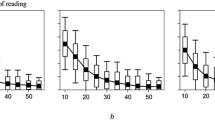Abstract
The maximal mutual information (channel capacity) between the input and output of a telephone connection was calculated, taking into account both the frequency and time domain aspects of this problem. This leads to define an « information index » which can be computed from objective measurements. Several examples are given, both for digital coders and for analogue transmission: they show that the information index has a very good correlation with the results of opinion tests. This index therefore constitutes the basis of a mathematical model for predicting the transmission performance of speech in a telephone network.
Résumé
On a calculé V information mutuelle maximale (capacité de la voie) entre l’origine et l’extrémité d’une chaîne de communication téléphonique, en tenant compte à la fois des aspects fréquentiels et temporels de ce problème. Ceci conduit à définir un « indice d’information » que l’on peut calculer numériquement à partir de mesures objectives. On donne plusieurs exemples, tant pour des codeurs numériques que pour la transmission analogique; ils montrent que l’indice d’information présente une très bonne corrélation avec les résultats d’essais d’opinion. Cet indice constitue donc la base d’un modèle mathématique destiné à prédire la qualité de transmission de la parole dans un réseau téléphonique.
Similar content being viewed by others
References
Shannon (C. E.). Communication in the presence of noise.Proceedings of the IRE (Jan. 1949),37, pp. 10–21.
Shannon (C. E.). A mathematical theory of communication.BSTJ (Jul.-Oct. 1948),27, pp. 379–423 and 623-656.
Gallager (R. G.). Information theory and reliable communication.John Wiley and Sons (1968), USA.
***. Models for predicting transmission quality from objective measurements, Supplement no; 3 in theCCITT Blue Book (1988), V, IXth Plenary Assembly, Melbourne.
Smith (B.). Instantaneous companding of quantized signals.BSTJ (May 1957),36, pp. 653–709.
Messerschmitt (D. G.). Quantizing for maximum output entropy (Memorandum-File 36674-12).Bell Laboratories (2 June 1970), USA.
Davenport (W. B. Jr). An experimental study of speech-wave probability distributions.JASA (July 1952),24, pp. 390–399.
Richards (D. L.). Distortion of speech by quantizing.Electronic Letters, GB (June 1967),3, no; 6, p. 230.
Fletcher (H.). Speech and hearing in communication.D. van Nostrand, USA (1961).
Alcaim (A.). Essai de détermination d’un indice objectif de mesure de la qualité des codeurs.CNET, report RP/LAA/TSS/208, Fr (May 1984).
Zwicker (E.), Feldtkeller (R.). Das Ohr als Nachrichtenempfanger, S.Hirzel Verlag, Stuttgart (F.R. Germ.) (1967).
Bosquet (J.). Un modèle de la fonction auditive monaurale.Revue HF, Brussels (Belg.) (1975),9, no; 11, pp. 325–335.
Richards (D. L.). Telecommunication by speech.Butterworths, GB (1973).
Kitawaki (N.), Itoh (K.), Honda (M.), Kakehi (K.) Comparison of objective speech quality measures for voiceband codecs.Proceedings ICASSP 82,2, pp. 1000–1003.
Castellino (P.), Modena (G.), Nebbia (L.), Scagliola (C). Bit-rate reduction by automatic adaptation of quantizer step-size in DPCM systems.Int. Zurich Seminar on Dig. Comm., Zurich (Switz.) (March 1974).
Noll (P.). Actaptive quantizing in speech coding systems.Int. Zurich Seminar on Dig. Comm., Zurich (Switz.) (March 1974).
Mc Dermott (B. J.), Scagliola (C), Goodman (D. J.). Perceptual and objective evaluation of speech processed by adaptive differential PCM.BSTJ (May-June 1978),57, no; 5, pp. 1597–1618.
CCITT. 1981–1984, Com. XII - Contribution no; 130 (Canada-BNR).
Goodman (D. J.), Nash (R. N.). Subjective quality of the same speech transmission conditions in seven different countries.Proceedings ICASSP 82,2, pp. 984–987.
Richards (D. L.), Barnes (B. J.). Pay-off between quantizing distortion and injected circuit noise,ibid., pp. 992–995.
CCITT. Recommendations.CCITT Blue book, V, IXth Plenary Assembly, Melbourne (1988), P. 76 and P. 79.
OPINE (Rev. 2.0.). Electrical communication laboratories.NTT, Japan (Sept. 1986).
Richards (D. L.). Calculation of opinion scores for telephone connections.Proceedings IEE Electronics (May 1974),121, pp. 313–323.
Osaka (N.), Kakehi (K.). Objective model for evaluating telephone transmission performance.Review of ECL, Japan (1986),34, no; 4, also reproduced in [22].
Lalou (J.). Quantization distortion and its effect on telephone transmission performance.CCITT Green Book, V, Geneva (Switz.) 1972, pp. 282–297 (The beginning of section 2.2. (p. 285) and section 5.3 (p. 291) of this text are superseded by sections 2.2 and 4 of this present paper).
Author information
Authors and Affiliations
Additional information
The French version of this paper is dealt with in the Technical note nt/dicet/ain/108 of cnet.
Rights and permissions
About this article
Cite this article
Lalou, J. The information index: An objective measure of speech transmission performance *. Ann. Télécommun. 45, 47–65 (1990). https://doi.org/10.1007/BF02999563
Received:
Accepted:
Issue Date:
DOI: https://doi.org/10.1007/BF02999563
Key words
- Information theory
- Transmission performance
- Telephone
- Analogue transmission
- Digital transmission
- Mutual information
- Channel capacity
- Sound quality




